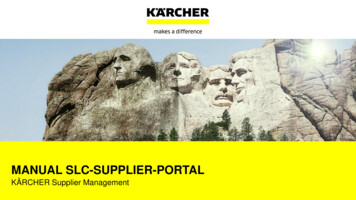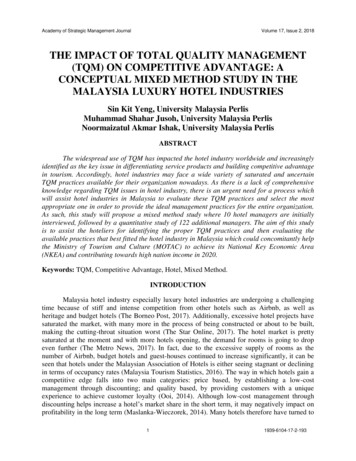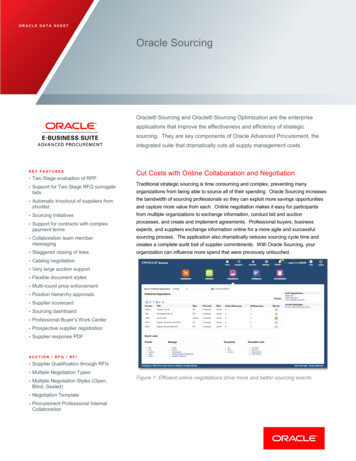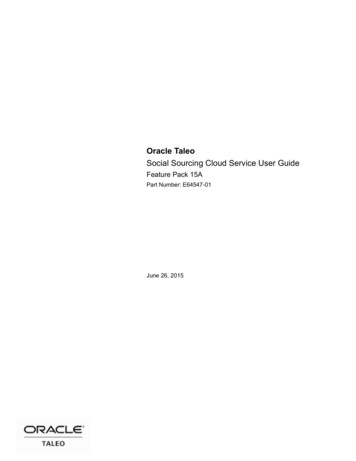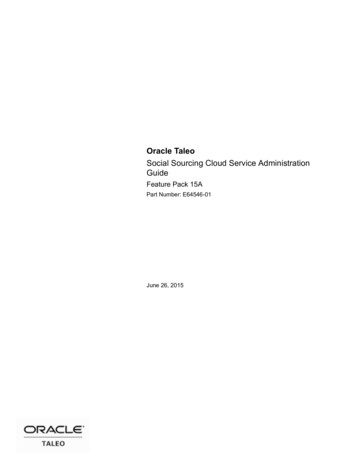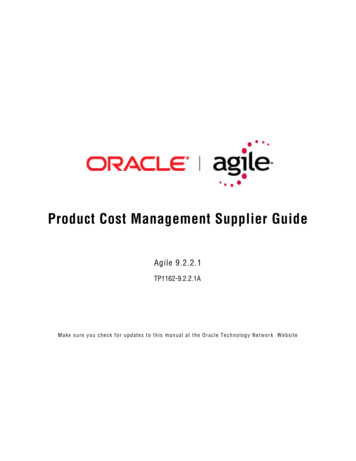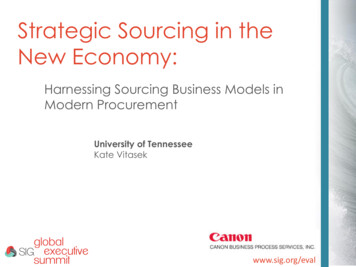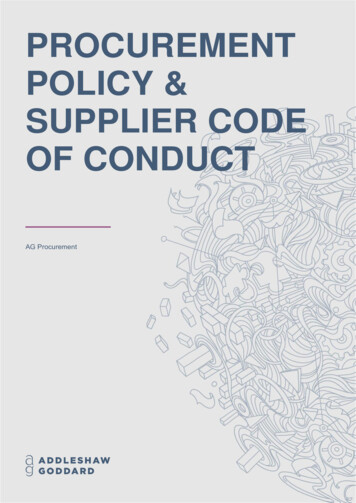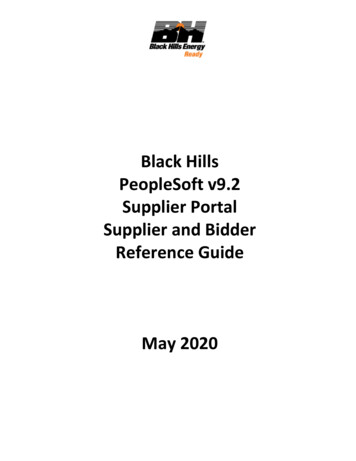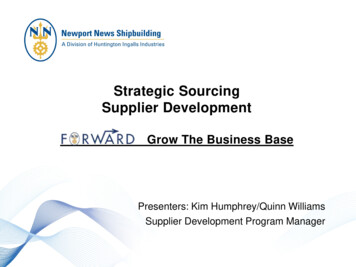
Transcription
Strategic SourcingSupplier DevelopmentGrow The Business BasePresenters: Kim Humphrey/Quinn WilliamsSupplier Development Program Manager
Strategic Sourcing - OverviewSupplier Data Over 55,000 purchase orders issued each year.NNS purchases from 48 States62% of active suppliers are considered Small BusinessesApproximately 40% of annual spend comes from commercial procurements. Facilities & Infrastructure Tools Capital Projects Benefits and other Human Resource functions IT systems and support Utilities Travel Freight2019 Supply Base Goals Cost ReductionsImproved Material AvailabilitySet Future Path for OutsourcingSupply Base Capability and Capacity is Key to success in ShipbuildingCopyright 2018 Huntington Ingalls Industries, Inc. All Rights Reserved
Supply Base/ Supplier Development ProgramThe Supply Base/ Supplier Development Program is the process of collaboratingwith suppliers to improve processes and product manufacturing capabilities.-Supply Base DevelopmentSupplier DevelopmentMarket IntelligenceTrainingOn-Line TrainingSupply Base Assessment / Integrated Enterprise PlanProject ManagementRisk ManagementLean Tools are Used to Drive Improvements and Eliminate Waste in the Value StreamCopyright 2018 Huntington Ingalls Industries, Inc. All Rights Reserved
Supply Base Development – Why is it needed?The goal of Supply Base Development is to (1) identify the right suppliers and(2) develop a partnership with these suppliers that will drive innovation andimprovements that benefit both organizationsNNS benchmarks best practices with professional organizations includingthe Association for Manufacturing Excellence (AME). These practices areshared with the supply base to:- Reduce Cost- Increase Capability and Capacity- Reduce Lead-times- Improve QualityPartner With Our Supply Base to Help Drive Innovation and Improvements4Copyright 2018 Huntington Ingalls Industries, Inc. All Rights Reserved
Supply Base Development - ProcessMarket Intelligence/Input from Multiple e eMetricsProspective/Existing SupplierContacts NNSHII Website/Email (O55)Receive and perform financial &Debarment checkfor all – Health Check (O55)Add to Supply BaseDevelopment Database (O55)O55 sends to O52 - Supplier Development toreview and determine NNS needs, withstakeholders, and if need exists, schedules a Meet& Greet, Webinar, or Conference CallMgt. ReviewDo NotPursue (O52)SendLetter/UpdateDatabase(O52)PursueIssue SupplierNumber(O55)PerformAssessments(Quality,STAV and/ orIEP)(O52/OO5)DetermineSupplierDevelopmentNeeds (O52)Issue RFQ(O52/O55)On BoardSupplier(O52)PutDevelopmentAction inplace andmonitor (O52)Publish newsuppliers toO51 (O52)ReportMetrics/Monthlyreports toSMT (O52)A Streamlined Process for Supplier Onboarding Helps Reduce Time and Ensure IntegrityCopyright 2018 Huntington Ingalls Industries, Inc. All Rights Reserved
Supplier DevelopmentExistingSupplier,New ProductCost, Schedule& FinancialRisksSupply BaseAssessmentNew SupplierOn-Boarding &DevelopmentTechnicalRiskSpendAnalyticsTool tingTechnicalAssessment &DevelopmentOperationalProcessAssessment &DevelopmentBusinessManagement &EducationWhat Improvement is Desired?QualificationInitiative Supplier Management Team (SMT)determine supplier development Supplier Technical Assessment andValidation (STAV) Supplier Engineering Advocates Approach & Commitment toContinuous Improvement Review & Improve Shared BusinessProcesses Workshop Assess & Develop a Lean Operation Root Cause Analysis On-line Training (NNS website) Supplier Development personnelcoordinate in-person Training atsupplier facility Webinars & Conferences Supplier Systems, Component andDeliverables QualificationWhat are the Process Areas of Concern?Supplier Vetting and Development Helps QualityCopyright 2018 Huntington Ingalls Industries, Inc. All Rights Reserved
Market IntelligenceThe Market Intelligence (MI) group monitors globalMacro Economic markets and produces intelligencefor the buying community.The MI group also monitors Geo-Political events thathave the potential to impact our materialdeliverables, such as mining strikes, coups, or otherarmed conflicts.The Global Market Impacts the Defense Supply ChainCopyright 2018 Huntington Ingalls Industries, Inc. All Rights Reserved
Online Training Introduction to the Purchasing ProcessRFQ I – The Format and How to Review ItRFQ II – Coded Notes, Appendices and FormsRFQ III – Specifications, Vendor Questions andPreviously Qualified MaterialPurchase Order and Work ReleaseCoded Notes and Standard ClausesFlow-downNDT – Non-Destructive TestingWelding and Brazing Procedure SubmittalWelding ProgramActual Total Cost vs. PriceAppendicesCapacity and Resource LoadingCertificate of ComplianceContract Delivery DateDrawing RequirementsEMI - Electromagnetic Interference I, The IntroductionEMI - Electromagnetic Interference II, The Requirementsand ControlsEMI - Electromagnetic Interference III, MIL-STD-461Exostar - Information ManagerExostar - The Supply Chain PlatformForm CPAR - Corrective and Preventive Action RequestForm PORA - Purchase Order Refresh ActionForm VDER - Vendor Drawing and Engineering ReviewForm VIR - Vendor Information Request Form VPAR - Vendor Procedure Approval RequestGlobal 8D Problem Solving and Corrective ActionTemplateHardware and Software Inspection OverviewHow To Deliver Material to NNSLean Introduction for the SkepticLevel I Over-stamping RequirementsMaterial Control LevelMaterial Marking and Labeling OverviewNewport News Shipbuilding - Supplier SurveyRoot Cause AnalysisSupplier Performance ScorecardSDI - Supplier Delegated InspectionShock RequirementsShock Test and Shock Extension BasicsSource InspectionSPARS - Shipbuilding Partners and SuppliersSteam Plant Cleanliness - NNS Purchase OrderRequirementsSteam Plant Cleanliness – The use of Covers, Caps,Seals (Shop Floor Personnel)Supply Chain Procurement Proposal ReviewUnderstanding the New NNS POOnline Training and Webinars Exist to Assist Suppliers in Key ProcessesCopyright 2018 Huntington Ingalls Industries, Inc. All Rights Reserved
Project Management The Project Management team focuses on the management of NNS’ Supply Base that aredeemed critical to the company’s performance that are in need of additional surveillance andoversight. Project Managers (PM) are involved with suppliers that are considered high risk because ofthe particular commodity or components that are procured and/or overall impact toconstruction. PM Functions: Manage all work contracted with the supplier to help gage overall supplier health Support the Procurement Office and Programs Establish a presence at the supplier’s facilities Provide assistance in the development of project plans and schedules Monitor/Report progress on the delivery of hardware and software Identify risks and develop mitigation strategies Hold supplier’s accountable to commitments Cross-program management and on-site schedule validation.The Project Management Team Monitors High Risk Project and Suppliers9Copyright 2018 Huntington Ingalls Industries, Inc. All Rights Reserved
Risk ManagementRisk Manager identify risks: As a possible mitigation strategy, develop new suppliers to provide competition in thesupply base due to poor delivery, quality or capacity performance Identified in the IEP/POAM/STAV assessments. Related to new suppliers who have not done previous business with NNS and areproviding complex, critical equipment or first time work which could inversely impactprogram schedule, cost, safety or quality. Schedule STAVs and manage opportunities for improvement from STAV reports. Based upon a segment of the supply base that has an insufficient number of capablesuppliers. Based upon market intelligence in regards to material projected cost increases,shortages.NNS Facilitates and Manages the Supplier, Supply Base and Shipbuilding Market Risks10Copyright 2018 Huntington Ingalls Industries, Inc. All Rights Reserved
Supplier Technical Assessment and Validation(STAV) ProgramImprovement Through CollaborationPresenter: Craig GarlandProgram Manager
Supplier Technical Assessment and Validation(STAV) Program – What is it?The STAV Program is an NNS initiative established in 2014 to betteralign procurements with our supplier capabilities and corecompetencies.– Bridges the gaps between part requirements, manufacturingcapabilities and demonstrated execution– Introduces NNS to additional supplier capabilities– Shifts NNS technical support from reactive, problem-solving toproactive, risk-mitigation– Reduces the costs and schedule impacts associated with after-thefact material investigationsSTAV benefits NNS and Supplier12Copyright 2018 Huntington Ingalls Industries, Inc. All Rights Reserved
Supplier Technical Assessment and Validation(STAV) Program – Why is it needed?NNS conducted over 150 formal material investigations over thepast year Some directly resulted in delay of delivering our warships to the Navy Many directly impacted the ship’s cost Causes shared by NNS and teCapability13FaultyExecutionMaterial Failures are Multi-FacetedCopyright 2018 Huntington Ingalls Industries, Inc. All Rights Reserved
Supplier Technical Assessment and Validation(STAV) Program – How is it conducted? On-site evaluation focused on observing operations, reviewingprocedures, and having open discussions with craftsmen andmanagement Conducted through a pairing of NNS SMEs with Supplier representativesto allow for one-on-one discussions. Conducted over the course of one or two days, depending on the size ofthe Supplier, complexity of the part(s), and number of SMEs required Typically includes a brief presentation by the Supplier of corecompetencies/capabilities and a facility tour, followed by breakoutsessions for the SME pairings. Concludes with an Assessment Report identifying observed strengths,weaknesses, and risks and recommended (or required) mitigation actions. After the on-site visit, NNS will brief the supplier on the STAV report andestablish a risk mitigation or development plan, as needed14Comprehensive – Focused – CollaborativeCopyright 2018 Huntington Ingalls Industries, Inc. All Rights Reserved
Lessons Learned NNS has conducted STAVs at 40 suppliers since 2014 Common weaknesses/risks being Identified include the following:– Inadequate/noncompliant NDT program (Level 3 certs, Written Practice, fabdocuments)– Inadequate/noncompliant welding programs (procedures, WWT, filler metalcontrol, preheat/interpass, etc)– Handling nonconforming material (instructions, storage, records)– Inadequate subtier supplier management (flowdown, surveillance)– Poor understanding of Geometrical Dimensioning and Tolerancing– Inadequate technical bench strength– Inadequate assembly instructions (assembly steps, fasteners, anaerobiccompound, lockwire, etc)–15Our Navy Depends on Us to Get It Right the First TimeCopyright 2018 Huntington Ingalls Industries, Inc. All Rights Reserved
NDT Program NDT Level III Examiners at prime contracted suppliers and their NDT sub-tier suppliersrecertify using a point system instead of recertifying by taking NDT examinations every 5years as required by Navy specifications (i.e., NAVSEA Technical Publication T9074-AS-GIB010/271). NDT Level III Examiners allow NDT Level IIs to use certificates in lieu of taking all 3recertification examinations required every 3 year as prescribed by NAVSEA TechnicalPublication T9074-AS-GIB-010/271. NDT Level III Examiners (prime contracted suppliers and their NDT sub-tier suppliers) notperforming oversight of their NDT Level II personnel as required by Navy specifications. Prime contracted suppliers’ NDT Level III Examiners not performing oversight of their NDTsub-tier NDT programs. NDT supplier’s written practice (personnel qualification document) procedures written toaerospace or commercial specifications instead of to NAVSEA Technical Publication T9074AS-GIB-010/271/ASNT SNT-TC-1A which is required for contracts where the followingNAVSEA Fabrication specifications for structure and piping/pressure vessel/machinery areinvoked: NAVSEA Technical Publications: T9074-AD-GIB-010/1688 (structure) and S9074AR-GIB-010/278 (piping/pressure vessel/machinery). NDT Level III Examiner approval signatures missing on the NDT Written Practice proceduresand Welder Workmanship Training procedures as required by NAVSEA Technical PublicationT9074-AS-GIB-010/271 and NAVSEA Technical Publication S9074-AQ-GIB-010/248. MT procedures not qualified (1/16” notch) and PT pre-cleaners not qualified in accordancewith NAVSEA Technical Publication T9074-AS-GIB-010/271.16Copyright 2018 Huntington Ingalls Industries, Inc. All Rights Reserved
Welding Program Welding procedure not NNS approved, applied to the correct products,or followed by the welder. Unqualified welders due to misunderstanding elements of WelderWorkmanship Training, vision testing, joint type, welding position,material type or thickness, and other process limitations. Filler metal not procured or verified to MIL-SPEC requirements, andimproperly stored or controlled in production. Welders with inadequate understanding of how to control preheat andinterpass temperature, and heat input. Welded components being heated improperly; e.g. not qualified bywelding procedures or ovens not properly controlled.17Copyright 2018 Huntington Ingalls Industries, Inc. All Rights Reserved
Nonconforming Material (NCM) NCM is clearly identified and segregated from conforming material. Identification & segregation ensures that material cannot be used. A procedure exists that explains how NCM is handled, identified &adjudicated with responsibilities assigned to specific individuals (suchas the QA manager). If adjudication includes acceptance of non-conformances, that thesupplier has sought customer approval, or has been given prior MRBauthority. Adjudication is accomplished in a timely manner. Non-conformance measurements, with Corrective And PreventiveActions or Root Cause Analysis, is regularly reviewed by Staffmanagement.18Copyright 2018 Huntington Ingalls Industries, Inc. All Rights Reserved
Subtier Supplier Management NNS Purchase Order requirements are clearly flowed down to subtiers and a process forverifying that subtiers understand is in place. A process exists for evaluating suppliers at the entry level and on a continuing basis. A list of approved suppliers of critical material is maintained and utilized by purchasing.There is a regular, and planned, review process of the list of approved suppliers. If Level I material is purchased, that a QC representative reviews the PO prior to releaseand acknowledges the supplier will be compliant to the NNS contract requirements. If specific testing data is a deliverable, that there is a formal review of the data providedagainst the associated specification or requirement. There is a record of the review withpass/fail clearly indicated. Critical material is inspected at receipt of material with clear inspection criteria. Supplier performance measurements includes first time quality data. On site surveillance of critical suppliers (heat treatment, welding, NDT, acceptancetesting) is performed on a regular basis, or as needed based on poor performance. Supplier performance data is regularly reviewed by Staff management.19Copyright 2018 Huntington Ingalls Industries, Inc. All Rights Reserved
Geometrical Dimensioning & Tolerancing ASME Y14.5 Geometric Dimensioning and Tolerancing (GD&T) is a method of applyingdimensions and tolerances; furthermore, it is used to interpret requirements. GD&T is utilized in New Construction Submarine and Aircraft Carrier Programs’drawings/models, especially in mechanical applications. The ability to interpret GD&T on drawings is imperative for any company to accurately verifyspecification requirements. Mechanical Engineers, CNC Programmers, Supervision and Quality Control must beknowledgeable of GD&T. It is also beneficial for shop floor operations that work to thesedrawings have a basic understanding of GD&T.20Copyright 2018 Huntington Ingalls Industries, Inc. All Rights Reserved
Technical Bench Strength NNS expects that suppliers will have a training matrix in place thatensures that their technical staff is fully qualified to perform the workthey are assigned. The majority of suppliers assessed lack a formal training matrix fortheir technical staff.21Copyright 2018 Huntington Ingalls Industries, Inc. All Rights Reserved
Assembly Instructions NNS expects suppliers of complex/critical components (e.g. hydrauliccylinders, accumulators, and valves) to have detailed written proceduresand OQE signoffs for assembly of those components. A number of suppliers lack written procedures governing theassembly of complex/critical components; instead, they rely oncomponent drawings which do not provide adequate instruction. Inmany cases, there is also no formal training on the assembly of thesecritical components. NNS expects suppliers of complex/critical components (e.g. hydrauliccylinders, accumulators, and valves) to have an understanding of thetooling/instrument use requirements for building bolted assemblies andare appropriately trained. A number of complex/critical component suppliers lack anunderstanding of the tooling process requirements for building boltedassemblies (e.g. use of self locking fasteners, temporary fasteners,lock-wire installation, anaerobic compound installation, bolted jointtorqueing, and hydraulic seal installation).22Copyright 2018 Huntington Ingalls Industries, Inc. All Rights Reserved
Questions and Answers23Copyright 2018 Huntington Ingalls Industries, Inc. All Rights Reserved
Copyright 2018 Huntington Ingalls Industries, Inc. All Rights Reserved
Project Management The Project Management team focuses on the management of NNS' Supply Base that are . Identified in the IEP/POAM/STAV assessments. Related to new suppliers who have not done previous business with NNS and are providing complex, critical equipment or first time work which could inversely impact .

